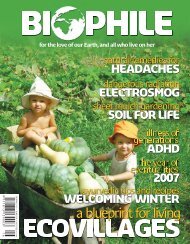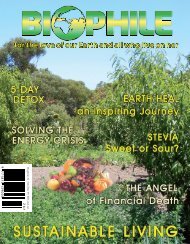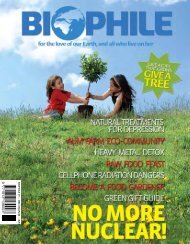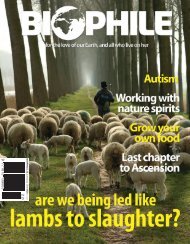IarranginggarbageA Buddhist approachto compostby Wendy JohnsonWendy has been gardening andpracticing meditat<strong>io</strong>n at Green GulchFarm Zen Center in northern Californiasince 1975.t wasalmostdarkwhen I cameupon thebobcat, walkingalone on asteep overgrowntrail far above theGreen Gulch valley.She had been deadfor weeks, her blackrimmedlips pulledback in a snarl of protest,tiny soot flies scouring herempty eye sockets. Her bellywas slit open and she lay, disemboweled,in her own dry blood. The acridstench of death rose off her matted fur. Iconsidered carrying the bobcat down tobury her in the farm compost p<strong>ile</strong> but decidedagainst it. She was her own sovereignpalace of decay, already well-consumed. Iplaced her, instead, off the trail, onto a softmound of chain fern and lady’s bed-strawand hurried down the mountain wh<strong>ile</strong> Icould still see.This was more than ten years ago, butI still think of that bobcat, especially inthis autumn season as we build the lastbig compost p<strong>ile</strong>s of the year, arranginggarbage in one giant heap sealed withmoldy oat straw drenched in stale greenpond water.Much as I love cross-legged sittingand the Bodhisattva Vows, makingcompost is my core relig<strong>io</strong>us practice.“Life into death into life,” intonedmy garden teacher Alan Chadwick as hesupervised us in the ancient alchemicalart of creating a compost p<strong>ile</strong>, a practicefollowed by Chinese farmers for more thanfour thousand years. I take my place in thisgardening lineage that reveres and relieson rot and decay as an abiding source ofsoil fertility.Compost is an untame culture, turningon the dark side of Nature’s wheel of lifewhere all beings come apart and are recombined.The same clan of microbes andmaggots, nematodes and mites, bacteriaand fungi that helped to decompose thebobcat on the Zen trail so many years agoare the engine of decomposit<strong>io</strong>n in everycompost p<strong>ile</strong>. The gardeners’ task is only tocreate a hospitable site where the cultureof compost can unfold.This work is deeply simple. All you needis a shady piece of ground large enough fora compost p<strong>ile</strong> that is at least 1x1x2m. Firstyou fork open the soil beneath your proposedp<strong>ile</strong> and arrange a base made of oldplant stalks, stems, and soft woody debris.Next you mound on top of this base a deeplayer of green, nitrogen-rich materials likegarden weeds and grass clippings, mixedwith animal manure and kitchen scraps.The following layer is dry, carbonaceousmaterial like straw and old leaves, or woodchips and sawdust, all well watered sothat your p<strong>ile</strong> is as moist as Avalokiteshvara’shuge heart. Continue to layer yourcompost green material and then let dryuntil you have a tall, noble p<strong>ile</strong>, as high asyou can reach.Every compost p<strong>ile</strong> is alive, a teemingsangha of bill<strong>io</strong>ns of invisible microorganismsdigesting your autumn mountain ofgarbage.In a fewshort daysa healthycompost p<strong>ile</strong>begins tosteam withmetaboliclife asclouds of heatlovingbacteria breakdown raw protein andcomplex carbohydrates intoamino acids and simple sugars,generating temperatures as high as72º C. This breakdown stage is followeda few weeks later by a buildup stage thatlasts for more than a month as complexfungal networks absorb the p<strong>ile</strong>’s free gasesinto their web work of mycelia, reducingleaching of nutrients, disarming pollutantsand disease pathogens, and <strong>ph</strong>ysicallybinding soil and compost together, creatingstab<strong>ile</strong> aggregates that increase waterinfiltrat<strong>io</strong>n and retent<strong>io</strong>n.In the last stage of decomposit<strong>io</strong>n a fewmonths later—or sooner, if you turn yourp<strong>ile</strong>—your mound will be alive with sweet,woodsy-smelling compost laced with up toone hundred industr<strong>io</strong>us compost insectsper square foot, intertwined with writhingred compost worms testifying by theirpresence that decomposit<strong>io</strong>n is complete.“All condit<strong>io</strong>ned existence is of thenature to come apart,” observed theBuddha twenty-five hundred years ago.Although this may not be corroboratedby the Pali canon, I am confident not onlythat the Budda’s teaching was stimulatedby upright sitting beneath a sacredpipal tree, but also that in the vicinity ofenlightenment there is always a smokingdung heap alive with bobcat bones and rottenmelons, arranged to become the deep,black ground of awakening.52 B<strong>io</strong><strong>ph</strong><strong>ile</strong> <strong>Issu</strong>e <strong>18</strong>
herbsforhealthHerbs foreveryday ailmentsby Nicci HayesHerbal Teas (or Infus<strong>io</strong>ns)When making an infus<strong>io</strong>n (or indeed any herbal remedy) remember to use organicallygrown herbs, and to wash the plant matter before you begin. Use the best quality wateryou have, as water with a high lime content is less efficient at extracting the medicinalproperties from herbs. Don’t panic about exact quantities - different plants have differentconcentrat<strong>io</strong>ns of active ingredients anyway. As a rough guideline for infus<strong>io</strong>ns use an 8cmsprig per cup (or 10 mls chopped fresh herbs, or a teaspoonful of dried herbs - althoughfresh herbs are preferable). Pour boiling water over the herbs. Place a saucer over the cup toprevent "goodness" escaping in the steam, and leave to steep for about five minutes. It reallyis as simple as making tea. (Remember to strain before drinking if you have chopped upthe leaves.) Add a little honey if you find the infus<strong>io</strong>n a little bland or distasteful. A genericguideline is to drink about three cups a day. Never drink the same herbal tea for more thanthree weeks at a stretch.LAVENDERLavender takes pride of place for me, notbecause it is particularlyversat<strong>ile</strong> as a healingherb - others such as fennel and yarrowfar outstrip it in that regard; but becauseit is just so beautiful. Said to bring protect<strong>io</strong>nto the household if planted at the frontgate, lavender has long been afavourite inthe garden, in herb lore, and in the medicinechest. Its Latin origin "lavare" to wash,bears testimony not only to it's refreshingsmell but also to antiseptic qualities.Much fuss is made in some books aboutensuring that only the flower of EnglishLavender (Lavandula angustifolia) is usedas a healing herb but in this (as in manythings) I follow Yvette van Wyk, one of ourbest-know South African gurus on herbs.Yvette suggests that all major species,including the French (Lavandula dentata)are fine, and that all aerial parts are usable.Lavender is perhaps best known asa headache cure. (Always remember ofcourse that the cause of a headache shouldbe investigated especially if headachespersist. Many headaches are simply theresult of mild dehydrat<strong>io</strong>n, and can thus bebest dealt with by drinking a tall glass ofclean water.Other common causes of headachesare constipat<strong>io</strong>n, neck tens<strong>io</strong>n, allergens,and bad lighting.) Lavender is particularlyeffective as a relief from tens<strong>io</strong>n headaches.Make a strong cup of lavender tea(officially called an infus<strong>io</strong>n - see box onmaking infus<strong>io</strong>ns). Sip the tea, and inhalethe wonderful smell for (almost) instantsoothing.Lavender is also fantastic for insomnia.Drink a cup of tea just before bedtime, orsleep with a sprig between your pillowand pillowcase. Also good for calming thenerves, lifting the spirits, and curing sorethroats (gargle with a warm infus<strong>io</strong>n) andbad breath (due not only to its sweet smellbut also its antiseptic qualities).As an antiseptic, I find the essentialoil the most convenient and never travelwithout it. (It is essential to use organicessential oils, as there are no pesticide orfungicide residues. The distillat<strong>io</strong>n processis also done slowly, with as little heat andpressure as possible. This ensures the therapeuticvalue of the oil.) It is mild enoughto be used straight on the skin if necessaryand is great for insect bites and smallinjuries. Ideally it should be combined withwarm water to clean out grazes, small cuts,and the like, and can also be used like thisas a gargle (add about 5 drops to a glass ofwarm water). Apply a drop to each templefor headache relief.Lavender oil is one of the best treatmentsfor minor burns. (Apply only afterthe burn has cooled.) Add a few drops ofessential oil to the bath to relieve tens<strong>io</strong>n,and to take the sting out of sunburn. Lavenderis one of the essential oils that is mildenough to be safe for children.BULBINE FRUTESCENS(I use the Latin name to avoid confus<strong>io</strong>n asthe common names bulbinella and bulbineseem to lead to arguments in herbs circles.The plant I mean has long thinnish succulentleaves, and spike-like clusters of smallyellow or orange star-shaped flowers.)This wonderful indigenous plant is, likeLavender, an outstanding remedy for minorburns, cuts and abras<strong>io</strong>ns, and insectbites. Simply break off a leaf and squeezethe juice or jelly onto affected areas.The ease of applicat<strong>io</strong>n makes this anexcellent herb to plant with your culinaryherbs just outside the kitchen door - not tocook with,but to use for kitchen mishapslike burns and cuts.The juice of Bulbine frutescens alsohelps to stop bleeding. Use also for roughand cracked skin and lips, ringworm, andcold sores. Scabies also seems relieved byregular applicat<strong>io</strong>n, but remember thatScabies is caused by a small bug, so anytreatment of scabies must be holistic andinclude thorough laundering and ironingof bedding and clothes (to get rid of familyand friends).BulbinefrutescensLavandulaangustifoliaB<strong>io</strong><strong>ph</strong><strong>ile</strong> <strong>Issu</strong>e <strong>18</strong>53

















